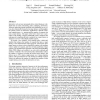Free Online Productivity Tools
i2Speak
i2Symbol
i2OCR
iTex2Img
iWeb2Print
iWeb2Shot
i2Type
iPdf2Split
iPdf2Merge
i2Bopomofo
i2Arabic
i2Style
i2Image
i2PDF
iLatex2Rtf
Sci2ools
PPOPP
2016
ACM
2016
ACM
Work stealing for interactive services to meet target latency
Interactive web services increasingly drive critical business workloads such as search, advertising, games, shopping, and finance. Whereas optimizing parallel programs and distributed server systems have historically focused on average latency and throughput, the primary metric for interactive applications is instead consistent responsiveness, i.e., minimizing the number of requests that miss a target latency. This paper is the first to show how to generalize work-stealing, which is traditionally used to minimize the makespan of a single parallel job, to optimize for a target latency in interactive services with multiple parallel requests. We design a new adaptive work stealing policy, called tailcontrol, that reduces the number of requests that miss a target latency. It uses instantaneous request progress, system load, and a target latency to choose when to parallelize requests with stealing, when to admit new requests, and when to limit parallelism of large requests. We implement ...
| Added | 09 Apr 2016 |
| Updated | 09 Apr 2016 |
| Type | Journal |
| Year | 2016 |
| Where | PPOPP |
| Authors | Jing Li, Kunal Agrawal, Sameh Elnikety, Yuxiong He, I-Ting Angelina Lee, Chenyang Lu, Kathryn S. McKinley |
Comments (0)

